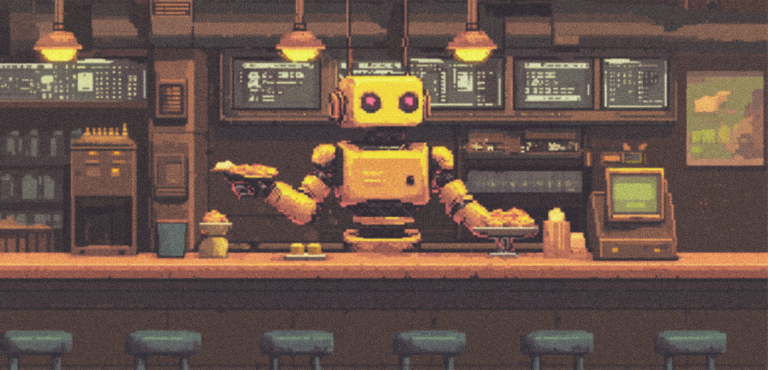
The Future is Now: The Rise of Everyday Robots
People have historically been fascinated by the idea of everyday robots. For decades, they were primarily found in science fiction, portrayed as far-off futuristic friends or aides who would transform our lives and work. Fast-forward to today, and that future is now a reality. Regular robots are no longer ideas from the pages of a book or the movies. They are here, subtly and significantly woven into our lives.
From personal robots like Samsung Ballie, which doubles as a rolling, AI-powered assistant, to Amazon’s Worker Robots changing warehouse logistics, to Starship Delivery Robots zooming about campuses and communities delivering meals, these devices are becoming more common and capable. The rise of everyday robots is not simply a tech enthusiast’s dream; it is a revolution that impacts all of us.
Samsung Ballie: your rolling robot companion
Samsung’s Ballie is among the most striking personal robots currently making headlines. Officially unveiled at the CES (Consumer Electronics Show) in 2020, Ballie is a small, ball-shaped robot that moves around your house, serving as a smart home controller, mobile assistant, or pet-like companion. Ballie’s adorable, pleasant design makes it approachable for families and individuals alike, unlike the imposing, humanoid robots we usually have in mind.
However, Ballie isn’t just for show. Powered by artificial intelligence, these everyday robots can understand your routines, respond to commands, and assist you in managing everyday tasks. For instance, it can roll around your house, monitor the environment, ensure your robotic vacuum is working, or warn you of a potential security breach. Though right now it seems non-essential, this kind of personal robot has great potential. Robots like Ballie could become necessary for home administration as AI advances, assisting elderly patients or early-warning systems for health emergencies.
Ballie’s distinctive feature is that it doesn’t attempt to mimic a human presence. Instead, it offers a more practical, intuitive experience that fits into the rhythm of our everyday lives. This robot is meant to be a silent, helpful presence in the background rather than replacing human interaction.
Amazon worker robots: transforming logistics
While Ballie is an example of a personal robot, the Worker Robots that Amazon has developed illustrate the opposite end of the spectrum. Amazon’s operations, notably those in its warehouses, have been subtly transforming thanks to these machines. Amazon has been spending significantly on automation for years, and its worker robots are one of the critical elements of this.
Rather than replacing human labour, Amazon’s robots—which include the Kiva system (now renamed Amazon Robotics)—are meant to assist them. Earlier, workers in a vast warehouse environment had to walk miles a day to retrieve products to fulfil orders. Robots today manage much of the movement. These precisely navigating warehouse floor robots move goods from one point to another, freeing human workers to concentrate on jobs requiring more complex problem-solving.
Amazon’s operations have become significantly more efficient due to the collaboration between human and robot workers, which has reduced costs and delivery times. With the explosion of online shopping, particularly following the COVID-19 pandemic, automation such as this has become an essential component of quick and dependable delivery systems.
However, it’s not without controversy. As robots become more capable of performing tasks that humans traditionally perform, critics argue that increased automation could result in the loss of jobs within the workforce. Although Amazon insists that automation is supposed to enhance rather than replace human efforts, the debate on the future of employment in the era of robotics is far from over.
Starship Delivery Robots: revolutionising Local Deliveries
You have most certainly seen a Starship delivery robot if you have ever been on a university campus or in a busy neighbourhood and seen a little, wheeled robot cruising along the pavement. These autonomous machines are completely transforming the way we think about local deliveries.
Thanks to their sleek and compact design, which allows them to navigate streets and walkways, these robots can deliver anything from groceries to takeaway meals without the need for a human driver. Starship Technologies, the company behind these robots, initially focused on deliveries in controlled locations such as university campuses, where the logistics were easier to manage. But they have now grown into more complex urban environments, offering a glimpse of what delivery might look like.
A robot can deliver your order right to your door instead of waiting for a human courier to come by bicycle or automobile. The beauty of these robots is in their simplicity. They’re built to perform a single task—delivery—and they do so efficiently. This form of automation has the potential to alleviate traffic congestion, cut carbon emissions, and provide faster, more dependable service in local delivery markets. With the ever-growing demand for convenience and instant delivery, robots like Starship are set to play an increasingly important role in how we get our goods.
Tesla Optimus: the humanoid everyday robots of the future
Revealed in 2024, Tesla’s Optimus robot marks one of the most aspirational developments in everyday robotics. Aiming to close the gap between industrial and personal robotics, Elon Musk’s humanoid robot Optimus is meant to undertake physical tasks typically performed by humans. Optimus is designed to manage more complicated, multi-functional roles than the more miniature, specialist robots usually employed in households and businesses nowadays.
According to Tesla, Optimus will work in factories, completing routine tasks like lifting heavy objects or even assembling components alongside human employees. Optimus might finally enter households with its human-like appearance and agility, assuming personal responsibilities such as assisting with household chores, providing caregiving support, or even acting as a companion for the elderly or disabled.
Distilled
The rise of everyday robots like the Tesla Optimus, Amazon’s Worker Robots, Samsung Ballie, and Starship Delivery Robots demonstrates that the future we once dreamed of is already here. These robots, which silently operate in the background to make things simpler, quicker, and more effective, are not merely novelty items; they are quickly becoming indispensable tools in our daily lives.